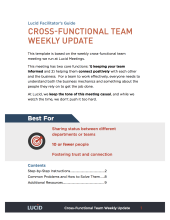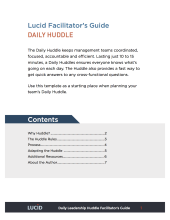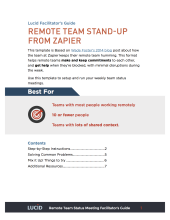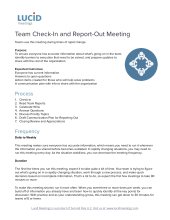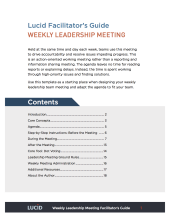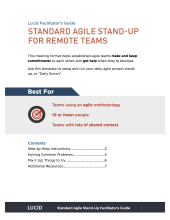You can find an introduction to Team Cadence Meetings in Chapter 17 of Where the Action Is. These resources will help you plan, run, and troubleshoot the specific Team Cadence Meetings your team needs.
Definition
Team Cadence Meetings are used to keep teams aligned towards a common goal, to keep everyone informed, and to ensure work momentum.
Questions Answered
- Since our last team meeting: What’s been done?
- What still needs doing? What’s changed?
- What do we need to focus on next?
Examples
- The Weekly Team Meeting
- The Daily Huddle
- The Shift-Change Meeting
- A Regular Committee Meeting
- A Working Session
Purpose
- Ensure group cohesion.
- Drive execution.
- Clarify immediate next steps.
Work Outcomes
- Clarity about what everyone is doing.
- Help solving anything preventing work completion.
- Information about circumstances affecting the planned work.
- Visibility into significant victories or setbacks.
- Documented decisions and action items.
Human Outcomes
- Increased trust.
- Connection to the group’s shared mission.
- A sense of belonging and of being valued by other team members.
- An appropriate sense of urgency to get work done.
Meeting Agenda Templates and Guides
How to Run a Cross-Functional Weekly Update MeetingElise Keith - This is the meeting agenda template the team at Lucid Meetings uses to run our weekly meetings. Needless to say, we think this format works pretty darn well. This meeting agenda template brings together leaders from different departments to share updates and reinforce their connections to the company and each other... [ more ] |
|
How to Run a Daily Leadership HuddleElise Keith - The Daily Huddle keeps management teams coordinated, focused, accountable and efficient. Lasting just 10 to 15 minutes, a Daily Huddles ensures everyone knows what’s going on each day. The Huddle also provides a fast way to get quick answers to any cross-functional questions. Use this meeting agenda template as a... [ more ] |
|
How to Run a Remote Team Check-In MeetingElise Keith - This meeting agenda template is inspired by Wade Foster's blog post about how the distributed team at Zapier keeps their work in synch and their team connected when meeting from different time zones. This meeting agenda template is best suited for small teams (10 or fewer people) who enjoy communicating in writing. |
|
How to run a Team Check-In and Report-Out MeetingElise Keith - Purpose: To ensure everyone has accurate information about what’s going on in the team, identify barriers to execution that need to be solved, and prepare updates to share with the rest of the organization. Expected Outcomes: Everyone has current information Answers to open questions Action items created for... [ more ] |
|
How to Run a Weekly Leadership Team MeetingElise Keith - Held at the same time and day each week, teams use this meeting to drive accountability and resolve issues impeding progress. This is an action-oriented working meeting rather than a reporting and information sharing meeting. The agenda leaves no time for reading reports or explaining delays. Instead, the time is... [ more ] |
|
How to Run an Agile Standup MeetingElise Keith - Fast, structured, and to-the-point, the agile stand-up is meant to keep a team fully in-synch on fast moving projects. As you might guess from the name, the "stand-up" was originally designed for teams that would stand up together in front of the board where they track their work using sticky notes. Most commonly... [ more ] |
Glossary of Meeting Terms
General Term
A meeting cadence is a pattern of regular team meetings. Short, frequent meetings increase a team's work momentum. Groups that provide oversight, such as boards and committees, hold longer meetings less frequently.
According to Job Embeddedness Theory, when an employee is more embedded within their organization, they are less likely to quit. Unlike simpler measures of job satisfaction or self-reports of engagement, job...
A standing meeting is any meeting that repeats on a predictable basis and creates an ongoing obligation on participant's calendars. For example, you may have a standing meeting with your boss every Tuesday at 2pm. A...
Technique
A check-in is a technique used at the beginning of a meeting to give everyone an opportunity to speak, and during meeting transitions to survey the group's current status. The simplest check-in is simply to ask each...
The one-phrase close is a technique used to end team meetings. Before the group leaves the meeting, each person takes a turn sharing one word or phrase about how they're feeling regarding the work completed during...
A meeting where everyone stands up rather than sits down is called a standing meeting. Standing is meant to help keep the meeting short, as no one gets too comfortable. Daily Huddles are often conducted as standing...
Virtual icebreakers are team-building exercises conducted during a meeting with attendees that are not in the same location. They help your team make a human connection, and can be especially useful when you run...
A weather report is a way to run meeting check-ins and check-outs developed by Diana Larsen for teams who meet on weekly basis.
During the check-in, each person gives their weather report for the previous week’s work...
The Write, Read, Discuss technique was popularized by Amazon as a way to replace PowerPoint presentations in meetings.a
Here's what it looks like:
Written Briefings: Provide detailed written reports and...
